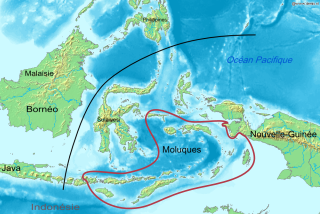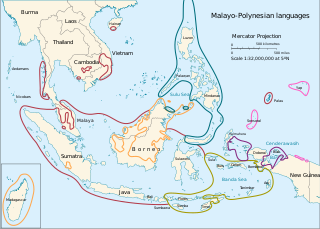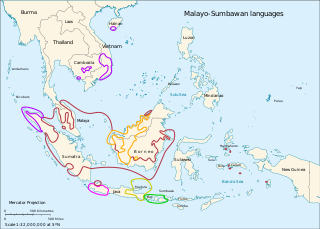| Nuclear Malayo-Polynesian | |
|---|---|
| Geographic distribution | Southeast Asia and the Pacific |
| Linguistic classification | Austronesian
|
| Glottolog | None |
 The principal branches of the Nuclear Malayo-Polynesian languages: Various western branches | |
The Nuclear Malayo-Polynesian languages are a putative branch of the Austronesian family, proposed by Zobel (2002), that are thought to have dispersed from a possible homeland in Sulawesi. They are called nuclear because they are the conceptual core of the Malayo-Polynesian family, including both Malay and Polynesian. Nuclear Malayo-Polynesian is found throughout Indonesia (apart from central Borneo, Sabah, and the north of Sulawesi), and into Melanesia and the Pacific.

The Austronesian languages are a language family that is widely dispersed throughout Maritime Southeast Asia, Madagascar and the islands of the Pacific Ocean, with a few members in continental Asia. Austronesian languages are spoken by about 386 million people (4.9%), making it the fifth-largest language family by number of speakers. Major Austronesian languages with the highest number of speakers are Malay, Javanese, and Filipino (Tagalog). The family contains 1,257 languages, which is the second most of any language family.

Sulawesi, formerly known as Celebes, is an island in Indonesia. One of the four Greater Sunda Islands, and the world's eleventh-largest island, it is situated east of Borneo, west of the Maluku Islands, and south of Mindanao and the Sulu Archipelago. Within Indonesia, only Sumatra, Borneo and Papua are larger in territory, and only Java and Sumatra have larger populations.
A nuclear family, elementary family or conjugal family is a family group consisting of two parents and their children. It is in contrast to a single-parent family, to the larger extended family, and to a family with more than two parents. Nuclear families typically center on a married couple; the nuclear family may have any number of children. There are differences in definition among observers; some definitions allow only biological children that are full-blood siblings, but others allow for a stepparent and any mix of dependent children including stepchildren and adopted children.
Nuclear Malayo-Polynesian languages are Malayo-Polynesian languages that have abandoned the Austronesian alignment inherited from Proto-Malayo-Polynesian syntax. Nuclear Malayo-Polynesian includes the traditional geographic groupings of Central–Eastern Malayo-Polynesian and part of Western Malayo-Polynesian.
Austronesian alignment, commonly known as the Philippine-type voice system, is a typologically unusual kind of morphosyntactic alignment in which "one argument can be marked as having a special relationship to the verb". This special relationship manifests itself as a voice affix on the verb that corresponds to a noun within the same clause that is either marked for a particular case or found in a privileged structural position within the clause or both.
In linguistics, syntax is the set of rules, principles, and processes that govern the structure of sentences in a given language, usually including word order. The term syntax is also used to refer to the study of such principles and processes. The goal of many syntacticians is to discover the syntactic rules common to all languages.

The Central–Eastern Malayo-Polynesian (CEMP) languages form a proposed branch of the Malayo-Polynesian languages consisting of over 700 languages.












